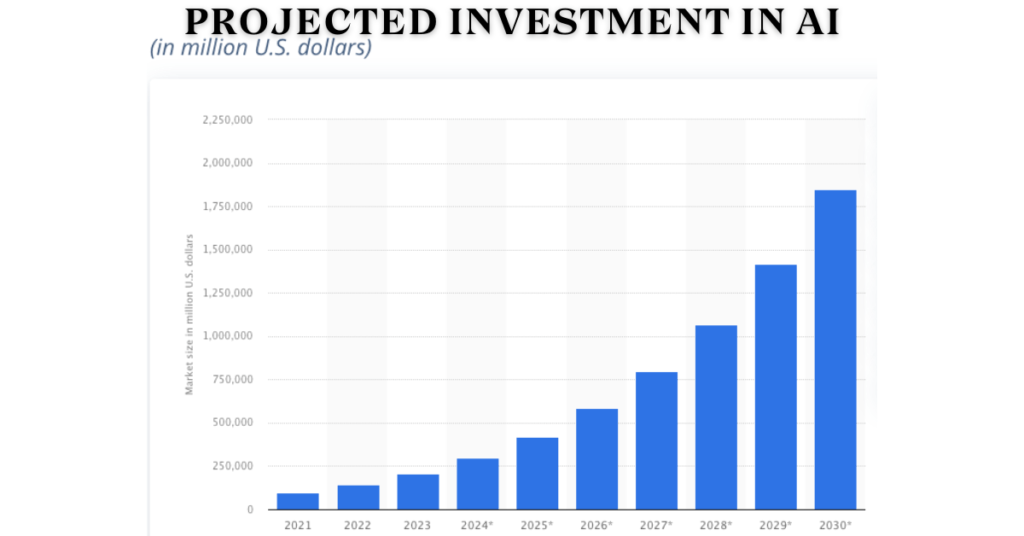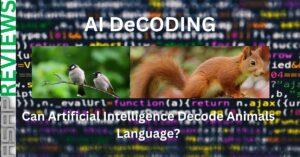Given its potential to revolutionize a number of facets of human existence, including governance, the environment and society, global investment in AI is one of the most significant and influential developments of our day. By 2025, the global AI market—which was estimated to be worth over 158.4 billion dollars in 2023—is predicted to have grown from its 2023 valuation of 142.3 billion dollars. The public and commercial sectors’ growing investments in AI, particularly in the US, which leads the world in AI investment, are the primary cause of this industry’s explosive expansion.
However, there are hazards and concerns for society, the environment and governance associated with AI in addition to its potential for innovation and progress. AI can affect many facets of human existence, including work, money, health, education, privacy, security, democracy and sustainability, in both beneficial and harmful ways. Therefore, it’s critical to comprehend the potential and problems facing these fields going forward, as well as how global investment in AI is affecting them.

Table of Contents
Impact of global investment in AI on society
Global investment in AI is having a big impact on society, posing both new potential and difficulties for the advancement and well-being of humans. This section will cover the ways that global investment in AI are influencing a range of social factors, including work, income, education, health and culture. We will also discuss some of the advantages and disadvantages of AI in terms of inclusiveness, equity and social welfare. Lastly, we will discuss a few moral and ethical conundrums raised by AI, including those involving privacy, consent, accountability and trust.
Positive effects of AI on social outcomes
The ability of AI to improve social outcomes through increased productivity, efficiency, quality and accessibility of a range of services and products, including healthcare, education, entertainment and communication is one of the benefits of global investment in AI for society. AI could promote creativity and innovation, as well as generate new businesses and jobs. For example, by 2030, artificial intelligence is predicted to produce 16 trillion dollars in increased economic value and 58 million net new jobs by 2022.
Some examples of how AI can improve social outcomes are:
Healthcare:
AI can assist with disease diagnosis, therapy recommendations, patient monitoring and medication discovery. AI may also improve access to and the cost-effectiveness of healthcare services, as well as enabling tailored and preventive treatment. AI, for instance, can identify breast cancer with 99% accuracy and 80% lower diagnosis costs.

Education:
AI can be used to evaluate pupils, provide feedback and tailor learning. AI has the potential to improve the caliber and variety of educational materials as well as enable lifelong and online learning. AI is able to customize learning routes for each student according to their goals, interests and abilities, for instance.
Entertainment:
AI can assist in producing and distributing varied and interesting content, like games, movies, music and artwork. In addition to facilitating new entertainment genres like virtual and augmented reality, AI may improve user experience and interactivity. AI, for instance, is capable of producing unique and lifelike pictures, sounds and narration.
Communication:
Translation, transcription and summarization are just a few of the ways AI might enhance and simplify communication. AI can also open up new communication channels and modes, such speech, gesture and emotion. AI is capable of real-time speech and text translation as well as the creation of emotive, natural-sounding voices.
Negative effects of AI on social risks and costs
The potential social risks and costs resulting from AI, such as job displacement, rising income inequality, reduced human agency and decreasing social unity, are another impact of global investment in AI on society. Additionally, AI has the potential to worsen already-existing societal issues like racism, exclusion and discrimination, particularly for weaker and excluded groups. By 2030, for instance, AI may have an impact on 375 million people, or 14% of the world’s workforce and increase the skills gap between high- and low-skilled workers as well as between developed and developing nations.
Some examples of how AI can pose social risks and costs are:
Employment:
AI can take the role of human labor in a variety of jobs and industries, including retail, manufacturing and transportation. AI has the potential to alter the type and standard of labor by necessitating the acquisition of new skills, boosting competitiveness and decreasing security and autonomy. AI has the potential to automate half of today’s labor tasks, for instance and increase the need for abilities like creativity, problem-solving and emotional intelligence.
Income:
AI has the potential to worsen divisions and income inequality inside and across nations. AI can also produce winners and losers based on factors like geography, income and educational attainment. AI has the potential, for instance, to decrease the percentage of revenue going to labor and low-skilled people and increase the percentage going to capital and highly skilled professionals.
Agency:
AI has the potential to reduce human agency and control on a personal and societal level. AI is also capable of influencing, convincing and pushing human behavior and decision-making. AI, for instance, has the ability to watch and observe human behavior as well as affect human preferences and decisions.
Cohesion:
AI has the potential to weaken trust and social bonds inside and between communities. AI can potentially lead to societal disintegration and isolation by decreasing emotion and human connection, for example. AI has the ability to produce false and misleading information as well as echo spaces and filter bubbles.
Ethical and moral dilemmas of AI
Global investment in AI has the potential to create moral and ethical challenges involving issues of privacy, permission, accountability and trust which is the third impact on society. Because these issues touch on the morals, legal rights and obligations of both humans and robots, they need to be carefully considered and regulated. Artificial intelligence (AI) has the potential to pose issues related to data ownership, consent, liability and trustworthiness.
Some examples of the ethical and moral dilemmas of AI are:
Privacy:
AI has the potential to compromise the security and privacy of private information, including biometric, financial and health data. In addition to enabling surveillance and profiling, AI can put people and organizations at risk of fraud, identity theft and cyberattacks. AI, for instance, is capable of gathering and analyzing enormous volumes of data and revealing personal and sensitive information.
Consent:
AI has the potential to violate people’s and groups’ autonomy and permission about the use, sharing and timing of their data. Additionally AI has the ability to take advantage of people’s biases and weaknesses in order to undermine their voluntary and informed engagement. AI, for instance, has the ability to affect people’s behavior and decisions by using and sharing data without the knowledge or agreement of the data subjects.

Accountability:
AI has the potential to make it more difficult for people and organizations to be accountable and responsible for things like the design, development, deployment and effect of AI systems. AI has the potential to hamper oversight and auditing of AI systems, as well as to conceal the explanations and transparency of AI systems. AI, for example, is capable of making complex, opaque, unpredictable decisions and behaviors that result in harm and destruction.
Trust:
AI has the potential to impact people’s and groups’ levels of confidence and trust, including how much they rely on and trust AI systems and their outputs. AI can also have an impact on people’s collaboration and sense of trust, including how they relate to and trust one another when AI systems are present. AI, for instance, has the potential to lead to tensions and disputes as well as inaccurate and incorrect outcomes.
Impact of global investment in AI on environment
The environment is being significantly impacted by global investment in AI, which can both benefit and threaten the long-term viability and strength of ecosystems and natural resources. This section will go over how worldwide or global investment in AI are influencing many environmental factors, including ecology, air, water and climate change.
We will also discuss some of the advantages and disadvantages of AI in relation to environmental depreciation and sensitivity. Lastly, we will talk about a few of the environmental justice and equity concerns related to AI, including distribution, accessibility, involvement and acknowledging the advantages and disadvantages for the environment.
Positive effects of AI on environmental sustainability and resilience
The ability of AI to improve environmental sustainability and resilience, including the prevention, response, conservation and restoration of natural resources and ecosystems, is one of the benefits of worldwide/global investment in AI for the environment. AI is also capable of monitoring, modeling and managing environmental problems as well as coming up with new ideas and solutions. AI, for example, can boost food yields by 25% by 2025 and help reduce greenhouse gas emissions by 4 gigatons by 2030.
Some examples of how AI can enhance environmental sustainability and resilience are:
Climate change:
By lowering energy use, maximizing the use of renewable energy sources and improving carbon capture and storage, AI can help to reduce the effects of climate change. By enhancing disaster preparedness, response and recovery as well as encouraging climate-resilient growth, AI can also aid in climate change adaptation. AI is capable of modeling climatic scenarios, predicting weather patterns and optimizing energy infrastructures.
Biodiversity:
By identifying and stopping illegal wildlife trade, poaching and deforestation, AI can contribute to biodiversity conservation. AI can aid in habitat restoration, re-wilding and reforestation, all of which contribute to biodiversity restoration. AI may, for instance, plants, monitor forest cover and identify and track endangered species.
Water:
By enhancing water distribution, quality and quantity, AI can assist in the management of water resources. AI can improve water efficiency, conservation and reuse which can help address water scarcity and security. A may recycle wastewater, improve irrigation systems and identify and minimize water leaks.
Air:
By cutting waste, pollutants and air pollution, AI can help enhance the quality of the air. AI can also be used with drones, satellites and sensors to forecast and monitor air quality. AI, for instance, can alert and inform citizens, filter and purify the air and control and improve industrial operations.
Negative effects of AI on environmental degradation and vulnerability
The potential threat that AI poses to environmental worsening and vulnerability, including the consumption, emission, pollution and extinction of natural resources and ecosystems, is another effect of global investment in AI on the environment. AI has the potential to generate new environmental dangers and hazards as well as expand human activity’s environmental footprint and impact. A, has the potential to produce up to 5.5 million tons of electronic garbage by 2021 and consume up to 1% of the world’s electricity by 2025.
Some examples of how AI can threaten environmental degradation and vulnerability are:
Consumption:
AI has the potential to raise demand for and consumption of natural resources like minerals, water and energy. AI has the ability to develop new consumption patterns and forms, like the sharing economy, e-commerce and digital consumption. AI can encourage online gaming, streaming and shopping while consuming significant amounts of water, electricity and rare earth metals.
Emission:
Artificial intelligence has the potential to boost greenhouse gas emissions, including nitrous oxide, carbon dioxide and methane. Blockchain, cloud computing and data centers are examples of new emission sources and types that AI can produce. AI has the capacity to use more electricity and produce more carbon emissions than some nations.
Pollution:
Artificial intelligence has the potential to worsen the deterioration of ecosystems and natural resources, including soil, water and air. AI has the potential to produce new types and levels of pollution, including light, noise and electronic waste. AI is capable of producing large amounts of light and noise as well as millions of tons of electrical garbage.
Extinction:
AI has enough potential to accelerate the loss and extinction of ecology, including microorganisms, plants and animals. Artificial Intelligence has the potential to generate novel risks and demands on biodiversity, including genetic engineering, synthetic biology and invasive species. AI has the ability to produce and modify genes, introduce and propagate invasive species and design and construct new organisms.
Environmental justice and equity issues of AI
The potential for increased environmental justice and equity concerns, such as distribution, access, involvement and acknowledgment of environmental benefits and liabilities, is a third consequence of worldwide/global investment in AI. Since these concerns affect the rights, interests and values of many people and groups—especially the impoverished the disadvantaged, and the vulnerable—careful thought and action are needed. For example, based on the location, gender and income of the individuals and groups AI can produce winners and losers.
Some examples of the environmental justice and equity issues of AI are:
Distribution:
AI can have an impact on how environmental benefits and burdens, like resources, services and impacts are allocated. Additionally, AI can lead to unfair and unequal allocation and distribution such as preferring some people and organizations over others and completely ignoring others. Artificial Intelligence (AI) has the potential to benefit the wealthy and metropolitan areas more than the depleted and rural areas, by increasing their access to resources and services.
Access:
AI has the ability to impact how easily available and beneficial environmental resources—like technology, expertise and information—are for people to use. Additionally, AI can lead to unjust and unequal availability and access such as denying some people and groups access to and use of AI or taking advantage of certain people and groups for their resources and data. AI has the potential, for example, to stifle access to the internet for over half of humanity and to misuse the resources and data of emerging nations.
Participation:
AI may have an impact on how people and groups engage in environmental governance and decision-making processes, including consultation, representation and empowerment. AI has the potential to lead to unfair and uneven involvement as well, such as the control of certain people and groups over others and the complete silence of other people and groups. AI has the power to silence indigenous peoples environmental concerns and voices and to control the environmental agenda and policies of developed nations.
Recognition:
AI can have an impact on how diverse people and groups’ environmental rights, interests and values—such as identity, dignity and diversity—are acknowledged and respected. Additionally, AI has the potential to provide unfair and unequal regard and recognition, such as favoring some people and groups over others and completely undervaluing others. AI has the potential, for instance, to undervalue the environmental knowledge and practices of local and traditional people and to discriminate against women and minorities in environmental sectors and jobs.
Impact of global investment in AI on governance
Global investment in AI is having a big impact on governance, both positively and negatively affecting the legitimacy and stability, efficacy and efficiency, and opportunities and difficulties associated with public policies and services. This section will address the ways in which global investment in AI are influencing security, authority, democracy and human rights, among other facets of governance.
We will also discuss some of the advantages and disadvantages of AI for governance procedures and results. We will now discuss some of the governance opportunities and problems associated with artificial intelligence, including regulation, coordination, stakeholder rivalry and collaboration across public and private sectors.
Positive effects of AI on governance effectiveness and efficiency
Global investment in AI has several benefits for governance, including increased efficacy and efficiency in areas like accountability, transparency, participation and innovation in public services and policy. AI can also help with governance difficulties by offering new ideas and solutions, as well as enhancing the quality and delivery of public goods and services. For example, AI can assist in cutting government expenses by 15% by 2025 and increasing government revenue by 10% by 2030.
Some examples of how AI can enhance governance effectiveness and efficiency are:
Transparency:
AI can contribute to the openness and transparency of government data and information, including performance, contracts and budgets. AI can also offer suggestions and comments while monitoring and assessing the impact of government services and policy. AI is capable of producing reports and dashboards as well as analyzing and visualizing government data.
Accountability:
AI can assist in enhancing the responsibility and accountability of public servants and organizations, including audits, inspections and sanctions. In addition to providing evidence and alarms, AI may assist in identifying and preventing waste, fraud and corruption in government operations and transactions. AI can detect and reveal abnormalities and disparities as well as audit and validate government spending.
Participation:
AI can support increased public and stakeholder engagement and participation in governance and decision-making processes, including consultation, empowerment and representation. AI may also offer platforms and tools for cooperation and co-creation, as well as help facilitate and enhance communication and interaction between the government and stakeholders and citizens. AI can establish and maintain online communities and networks as well as facilitate offline and online surveys, petitions and discussions.
Innovation:
AI can support government services and policies that are creative and innovative, including inspiration, experimentation and scale. AI can also offer new and improved methods of doing things, as well as assist in addressing and resolving difficult and wicked governance issues. AI is capable of producing and testing novel concepts and ideas as well as scaling and duplicating effective procedures and models.
Negative effects of AI on governance legitimacy and stability
Global investment in AI has the potential to undermine the stability and legitimacy of governmental actors and institutions, including those that uphold democracy, security, autonomy and human rights. AI has the potential to erode public and stakeholder faith in government, as well as generate new risks and threats to governance. AI has the potential to upset the balance of power and influence between nations and regions as well as present threats to physical and cyber security.
Some examples of how AI can challenge governance legitimacy and stability are:
Security:
Government infrastructure and systems, including networks, databases and buildings, may be at risk from artificial intelligence. AI can potentially lead to new kinds and intensities of violence and warfare, as well as facilitate and improve physical and cyberattacks. AI is capable of creating and deploying autonomous weapons and drones, as well as hacking and destroying government infrastructure and systems.
Sovereignty:
AI has the potential to undermine a nation’s sovereignty and legal power over its people, borders and natural resources. AI has the capacity to establish new and alternative actors and entities, as well as new degrees and forms of order and government. AI, for instance, has the ability to develop and maintain decentralized, self-governing systems and platforms as well as bypass and disrupt laws and other restrictions.
Democracy:
AI may have an impact on how government is represented in elections, parties and legislatures, among other institutions. Additionally, AI has the power to sway and manipulate voter behavior and decision-making, as well as to amplify and redefine populism and conflict. AI has the ability to produce and disseminate misinformation and false information, as well as meddle in and disrupt electoral and voting processes.
Human rights:
AI has the potential to violate peoples and stakeholders human rights and dignity, including equality, freedom and privacy. AI can potentially lead to new kinds and intensities of inequality and repression, as well as discriminate against and exclude particular people and groups. AI has the ability to gather and use private and sensitive data without authorization or security, as well as to perpetuate unfair and biased results and effects.
Governance challenges and opportunities of AI
Global AI investment has the potential to bring out new governance opportunities and problems including regulation, coordination, stakeholder rivalry and collaboration across public and private sectors. This is the third consequence of global investment in AI on governance. Because they involve the roles, interests and values of various actors and sectors, including the government, the corporate sector and the civil society these possibilities and challenges call for serious thought and action. AI has the potential to develop alliances and benefits as well as gaps and conflicts across various actors and industries.
Some examples of the governance challenges and opportunities of AI are:
Regulation:
Artificial Intelligence has the potential to generate new and improved rules, norms and principles for AI governance. AI can also contribute to factors like unpredictability, diversity and dynamism that make regulating and overseeing AI more difficult and complex. AI may need and facilitate the development of new and improved AI governance and regulation frameworks, including co- and self-regulation methods as well as ethical, legal and social implications (ELSI) frameworks.
Coordination:
More and better coordination and alignment of AI policies and tactics, both inside and between nations and regions, may become necessary as a result of AI. AI can also lead to issues like fragmentation, divergence and conflict that make it more difficult and complex to coordinate and align AI policies and plans. AI has the potential to need and facilitate enhanced coordination and alignment of AI policies and plans including bilateral and international agreements and initiatives, as well as national and regional strategies.
Cooperation:
AI has the potential to increase and improve the amount and quality of cooperation and coordination across AI agents and stakeholders, both within and between sectors and domains. Along with competition, mistrust and resistance, AI can also make working and collaborating with AI actors and stakeholders challenging and complex. For instance, public-private partnerships (PPPs), multi-stakeholder platforms and networks and other AI actors and stakeholders may need to collaborate and cooperate more and better as a result of AI.
Competition:
AI has the potential to increase and improve the need for AI-related product and service innovation and competition, both within and between markets and industries. Artificial intelligence has the potential to cause disruption, dominance and exclusion, as well as make it more difficult and complex to innovate and compete with AI goods and services. AI has the potential to both need and facilitate greater competition and innovation in AI-related products and services. This includes the creation of innovation hubs and ecosystems, as well as market regulation and stimulation.
Synopsis
We have looked at the ways that global investments in AI are impacting government, the environment and society. We have also talked about some of the major problems and trends that still need to be resolved. As we’ve seen artificial intelligence (AI) can affect human existence in a variety of ways including work, money, health, education, privacy, security, democracy and sustainability.
We have also observed that AI can lead to challenges related to environmental justice and equality, including distribution, access, participation and recognition of environmental benefits and liabilities, as well as ethical and moral problems including privacy, consent, accountability and trust. Furthermore, AI has the potential to bring out new opportunities and problems for governance, including those related to regulation, coordination, cooperation, and rivalry between public and private entities.
We have offered some best practices and recommendations based on our analysis for various stakeholders and industries involved in AI investment globally, including enterprises, consumers, investors and governments. These suggestions and best practices are meant to maximize AI’s advantages while lowering its expenses and hazards and guaranteeing that the technology is morally and responsibly developed as well as long-lasting.




